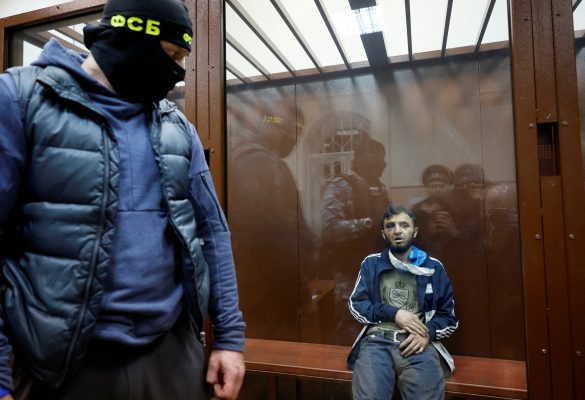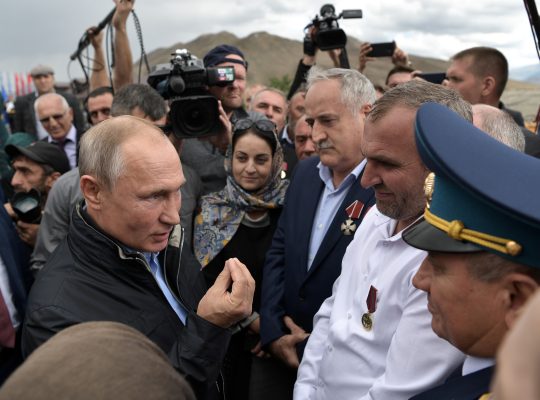Most of the people who left Ukraine after the February invasion weren’t ready to do so, and there were as many different experiences as there were people crossing the border. Now those refugees can think about the future, there’s a similar range of outlooks: some plan to go back regardless of the risks, some have nowhere to return to, and others have already started building new lives abroad.
According to United Nations (UN) data, there have been 12.6 million border crossings from Ukraine since the war began. More than 7.2 million people are refugees in Europe and a further 6.9 million are “internally displaced” within Ukraine’s borders. These are the official figures, and don’t include unregistered migration, so the actual numbers may be much higher. In addition, further 2-3 million more people are expected to be forced from their homes this winter, the World Health Organization (WHO) says.
Arsen Striletskiy, a guest lecturer at Ukrainian Catholic University who is working on a book about the sociology of migration in times of war, said accurate data has been hard to come by since February. UkrStat, the Ukrainian government agency, ceased to function after the full-scale invasion and official estimates come mostly from the UN, he said. The true figures will probably never be known.
A major issue in the second half of the year has been the return of refugees. The trend is clear and correlates with events on the battlefield. The first big wave of returns followed the liberation of the north of Ukraine and the securing of the capital, and similar trends have been seen during the summer, when the Russian army was unable to advance significantly on any front. More movement can be expected following the recent defeats of the Russians in Kharkiv and Kherson regions.
But the traffic is not all one way. While many are returning, some people are still leaving, mainly as a result of Russian threats to use nuclear weapons, the approach of winter without adequate heating, and the plunge in living standards as a result of the Kremlin’s targeting of vital infrastructure. The overwhelming motive is fear. Despite its military successes, Ukraine is still a very dangerous place to be.
As refugees grapple with decisions about their futures, the suspension or lowering of support in host countries is encouraging some to return. For example, in Poland, the country that welcomed the greatest number of Ukrainian refugees (about 1.5 million), will require them to cover a part of their living costs in places of collective accommodation from January. Similar policy changes can be seen in other countries that have become a second home for tens of thousands of Ukrainians. These steps, while understandable, are disproportionately driving the return of less wealthy people, regardless of whether they feel ready to do so.
According to a survey of Ukrainian refugees by the Razumkov Center, a Kyiv-based think tank, the vast majority of those who fled abroad intend to return: 36% will come back when they are sure their home district is safe; 35% when the war ends, and 13% after a year or more of peace. About 11% plan to return to Ukraine in the near future, and 7% wish to remain abroad.
Olga, a 19-year-old student from Odesa, moved to France after the invasion and returned to her studies in Ukraine once the Russian threat to her hometown subsided. She said she was met with kindness and support in western Europe — and was struck by the contrast with the cruelty and violence she’d seen taking over her homeland. But she knew she wanted to return to Ukraine as soon as she could.
“Everything was very surreal. I read the news, it terrified me, but life around me in provincial France was just perfect,” she said in an interview. “When I returned to my home, my district, and the city where I grew up, I felt firm support beneath my feet. It is much stronger than in an unfamiliar, albeit safe, place.”
She said she understood why some people her age have chosen to stay out of Ukraine. “High-quality education and self-improvement abroad are important to young people; it’s good that Ukrainians now have such opportunities,” she said. “But for me, studying here in Ukraine, focusing on Ukrainian social processes is more important.”
Not everyone has been able to make such a straightforward decision, in some cases because they were already refugees from Russia’s initial invasion of the country in 2014.
For Milana, a 19-year-old student of sociology, this year’s forced migration was not her first. In 2014, she left occupied Donetsk and moved to Lviv, in western Ukraine, where for eight years, she received neither state aid nor housing. When rents rose in the spring, she couldn’t afford to stay. Her relatives own an apartment in Spain, so she decided to move there.
On the one hand, she feels much better abroad, where she is far from the war and now has a sense of emotional stability. “Life is easier both financially and, though it is banal, because of the view outside the window,” she said. But separation from her own society, despite her knowledge of English, is ever-present. The lack of friends, cultural differences, and the language barrier is challenging.
Milana said she does not plan to return to Ukraine in the near future, as she has nowhere to live, but wants to go back after earning some money and gaining experience and education abroad, so she can start a business.
Another disincentive to return is that, for many Ukrainian refugees, their new countries are starting to feel a bit like home. They are grateful to the people and governments accepting them and are conscious they need to try to be as useful as possible. Their hosts are benefiting as a result, including neighboring Poland.
“We spent 3.5bn zlotys ($800m) on helping Ukrainians, but the calculations of the vice president of the Polish Development Fund, Bartosz Marczuk, show we received 10bn zlotys from the taxes they paid,” said Professor Maciej Duszczyk, from the Center for Migration Studies at the University of Warsaw.
Every month of the war has seen people returning, but as they plan for the future, Ukrainian authorities know that this steady flow will need to become a flood if they are to restore the nation. There will be a huge need for workers to rebuild once the Russians are expelled, and it will be Ukraine’s turn to welcome outsiders.
“We will have a catastrophic economic situation, we will have to rebuild, and return the money that is invested in us and will continue to be invested,” the Catholic University’s Arsen Striletskiy said. “The problem is whether other, new people, will come. No one will stay to starve, many will continue to leave and look for something better, so we will need an influx of people.”
Ukraine and Europe still have to solve many issues related to the migration crisis caused by Russian aggression, but the current situation offers an opportunity to rethink policy towards migrants in general and open new ways to improve support. The evidence so far is that aid can be mutually beneficial, both during the rest of the war and in the rebuilding thereafter.
Kateryna Panasiuk is an author and journalist studying politics at the Ukrainian Catholic University. When war came to Ukraine, she set up a volunteer project to collect and share stories of Ukrainians affected by the war.
Mykyta Vorobiov is a freelance journalist studying politics at the Ukrainian Catholic University. Forced to leave Kyiv when war broke out, he has since combined work at Lviv City Council with coordinating a journalism project and editing articles.
Europe’s Edge is CEPA’s online journal covering critical topics on the foreign policy docket across Europe and North America. All opinions are those of the author and do not necessarily represent the position or views of the institutions they represent or the Center for European Policy Analysis.





